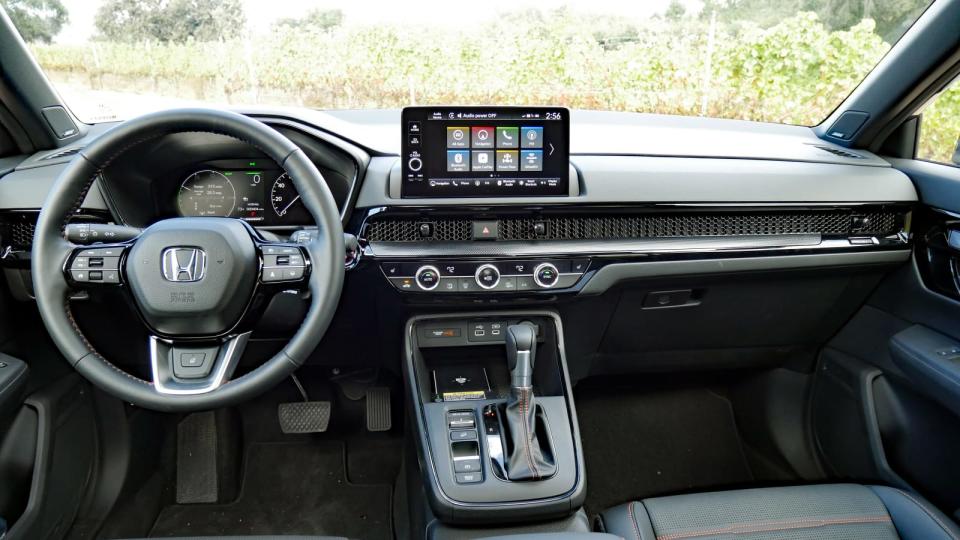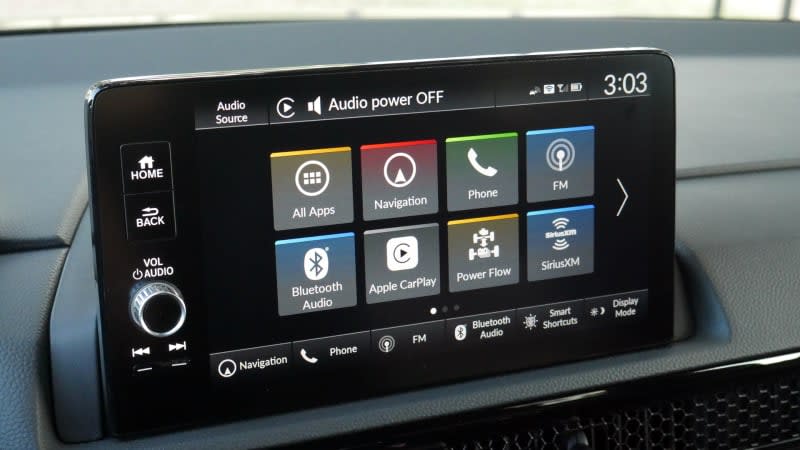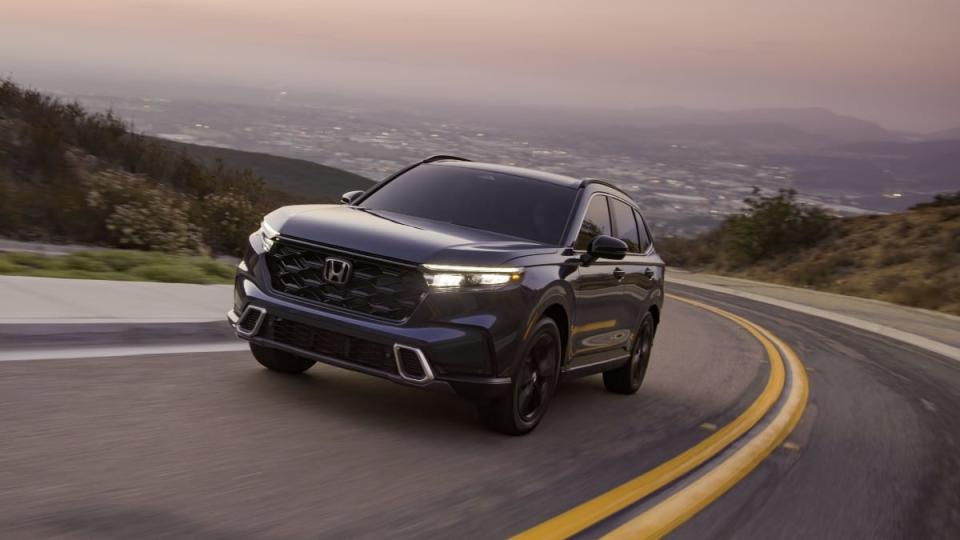2024 Honda CR-V Buying Guide: It leads the class of compact SUVs and looks good doing it

Pros: High-quality and great-looking interior; excellent hybrid; strong safety credentials; refined and responsive driving experience
Cons: No plug-in hybrid and off-road models; no spare tire in hybrid; simple base touchscreen; higher prices than some rivals
After a full year on the market and multiple testing opportunities, including a comparison test victory, we feel safe in declaring the 2024 Honda CR-V to be our top choice in the compact SUV segment. Quite simply, it does everything well and, unlike past CR-V efforts, looks good doing it.
If you want to narrow things down a bit, we most recommend the Sport, Sport-L and Sport Touring models. Not because we love cars and the word “Sport” gets us excited (it does), but because ironically, all the CR-V’s “Sport” trims are the only way to get the excellent hybrid powertrain and vice versa. The CR-V’s hybrid is more powerful and, not surprisingly, more efficient than the perfectly sufficient 1.5-liter turbo inline-four found in the more traditional LX, EX and EX-L trim levels. It’s also just better to drive due to simulated shifts that make it feel more normal (the 1.5 uses a shift-less CVT).
Like past CR-Vs, the 2024 edition checks off all the boxes expected of sensible family transport: spacious for people and their stuff, strong safety credentials, fuel efficient, well-equipped, well-built, and likely to be reliable and hold its value. That it looks so much better now and is better to drive gives it that extra shove to place it just atop a truly impressive lineup of competitors that still need to be considered: the Kia Sportage, Hyundai Tucson, Toyota RAV4, Mazda CX-50 and Nissan Rogue.
Interior & Technology | Passenger & Cargo Space | Performance & Fuel Economy
What it's like to drive | Pricing & Trim Levels | Crash Ratings & Safety Features
What's new for 2024?
The CR-V was all-new last year, and there are no major changes for ’24. There is a new Sport-L trim level, however, which bridges the sizable price and equipment gap between the hybrid-only Sport and Sport Touring trims.

What are the CR-V interior and in-car technology like?
Some may prefer the showier cabins of certain competitors (two of our editors did in our CR-V vs Sportage comparison test), but the clean, sophisticated look of the CR-V interior is pure, classic Honda. There’s something about the blend of metal honeycomb vents, piano black and chrome knobs that evoke a really cool Fender amp. The design and styling should be timeless.
Importantly, though, it remains well made and extremely functional. There’s ample storage space and cupholders. The dash is low, and in conjunction with the front pillars, visibility is excellent and there’s a strong sense of spaciousness. All the switchgear feels high-quality with tight, solid action whether it's a turn signal stalk or the highly welcome climate control dials. There’s even a conventional shifter instead of some confusing, different-for-different-sake electronic doo-dad.
As for instruments and infotainment, the CR-V features an analog speedometer combined with a 7-inch screen that can display the tachometer and other information. The standard infotainment display is a 7-inch touchscreen (below left) with volume and tuning knobs and a couple of physical menu buttons. It’s awfully rudimentary in terms of appearance and capability, but if you’re mostly going to use the standard Apple CarPlay and Android Auto, that may not matter. The EX-L, Sport-L and Sport Touring get a 9-inch touchscreen with configurable touch-operated menu shortcut buttons that stay docked on the screen. It has far more capability and features, looks modern enough, and responds with sufficient speed to inputs. It’s fully competitive with most rivals, though we still prefer the Hyundai/Kia systems.


How big is the CR-V?
If you're coming from the previous generation, this CR-V is a bit bigger than before, but you’re unlikely to notice much of a difference inside. It continues to be one of the biggest and most passenger-friendly compact SUVs. The back seat is very spacious for those of long leg and for rear-facing child seats. It also reclines to a great degree, increasing comfort. Front seat adjustability and comfort are excellent.
Cargo space differs based on trim level. The EX and EX-L have a dual-level cargo floor, which frees up some extra space while still maintaining a fully flat load floor when you lower the back seat. The base LX and all the hybrid-powered Sport trims lack this, meaning they have a bit less space (3 cubic-feet to be precise) and a step in the middle of the floor when you lower the back seat. The hybrids also lack a spare tire, unlike the RAV4 and Sportage hybrids. In our cargo test of a hybrid-powered CR-V, we managed to fit our standard selection of six suitcases plus a 38-quart cooler, two smaller coolers and a kid-carrying hiking backpack. This is a lot of stuff for a five-passenger vehicle, but not quite as good as the Sportage, Tucson and RAV4.


What are the CR-V fuel economy and performance specs?
The CR-V LX, EX and EX-L are powered by a 1.5-liter turbocharged inline-four that produces 190 horsepower and 179 pound-feet of torque. Power goes through a continuously variable transmission and on to either just the front wheels or all four with the optional all-wheel drive. Fuel economy is excellent for an SUV at 28 mpg city, 34 mpg highway and 30 mpg combined with FWD, and 29/32/27 with AWD.
Every trim level with the word “Sport” in its name has a hybrid powertrain. It uses a naturally aspirated 2.0-liter four-cylinder and a pair of electric motors. Under most circumstances, it operates as a series hybrid with the gas engine producing electricity and the larger of the two motors turning the wheels. There are some situations where the gas engine can provide drive power directly. Combined power is 204 horsepower and 247 pound-feet of torque. Front- and all-wheel drive are available, with the Sport Touring being AWD-only. Fuel economy stands at 43 mpg city, 36 mpg highway and 40 mpg combined with FWD, and 40/34/37 with AWD. According to the EPA’s average fuel cost estimates, you’d save $450 per year by going with the hybrid.

What's the CR-V like to drive?
Honda has recaptured some of its old driving dynamics mojo with the latest CR-V. It is once again one of the more engaging compact SUVs to drive, although that's not exactly a high bar, and it does depend on which powertrain you get. Perhaps surprisingly, the better performer is the hybrid. The base turbo engine is smooth, but can be noisy, in part due to its CVT that still has some rubber-band characteristics and also makes the powertrain feel somewhat unresponsive. Power is perfectly adequate, but not inspiring. The hybrid, meanwhile, is not only more powerful, but by powering the wheels almost exclusively with its electric motor (the engine is mostly just there to generate electricity), it provides the sort of smooth, effortless power off the line normally associated with EVs. The powertrain also simulates shifts when accelerating, making it sound and feel a lot more normal than other hybrids like the Toyota RAV4 and the CVT-equipped base turbo engine.
Compared to the previous-generation CR-V, the 2023 is notably more refined and stable. Driven back-to-back, it's surprising how much the old CR-V wobbled about with excessive body motions. The new one is far tidier and results in one of the more composed vehicles in the segment. The steering is also very precise with nice, consistent weighting that allows you to feel more connected to the road. Overall, we preferred driving the CR-V over another favorite of ours, the Kia Sportage Hybrid, but those seeking a sportier feel will still prefer a Mazda CX-5 or CX-50.

 Yahoo Autos
Yahoo Autos 
